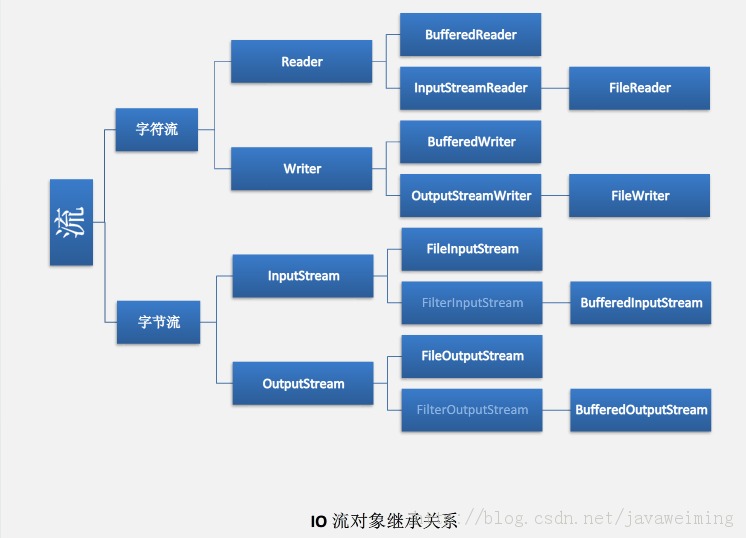引言:
關於java IO流的操作是非常常見的,基本上每個項目都會用到,每次遇到都是去網上找一找就行了,屢試不爽。上次突然一個同事問了我java文件的讀取,我一下子就懵了第一反應就是去網上找,雖然也能找到,但自己總感覺不是很踏實,所以今天就抽空看了看java IO流的一些操作,感覺還是很有收獲的,順便總結些資料,方便以後進一步的學習...
IO流的分類:
1、根據流的數據對象來分:
高端流:所有的內存中的流都是高端流,比如:InputStreamReader
低端流:所有的外界設備中的流都是低端流,比如InputStream,OutputStream
如何區分:所有的流對象的後綴中包含Reader或者Writer的都是高端流,反之,則基本上為低端流,不過也有例外,比如PrintStream就是高端流
2、根據數據的流向來分:
輸出流:是用來寫數據的,是由程序(內存)--->外界設備
輸入流:是用來讀數據的,是由外界設備--->程序(內存)
如何區分:一般來說輸入流帶有Input,輸出流帶有Output
3、根據流數據的格式來分:
字節流:處理聲音或者圖片等二進制的數據的流,比如InputStream
字符流:處理文本數據(如txt文件)的流,比如InputStreamReader
如何區分:可用高低端流來區分,所有的低端流都是字節流,所有的高端流都是字符流
4、根據流數據的包裝過程來分:
原始流:在實例化流的對象的過程中,不需要傳入另外一個流作為自己構造方法的參數的流,稱之為原始流。
包裝流:在實例化流的對象的過程中,需要傳入另外一個流作為自己構造方法發參數的流,稱之為包裝流。
如何區分:所以的低端流都是原始流,所以的高端流都是包裝流
IO流對象的繼承關系(如下圖):
下面來看一些具體的代碼例子:
按字節來讀取文件
代碼如下:
public class ReadFromFile {
/**
* 以字節為單位讀取文件,常用於讀二進制文件,如圖片、聲音、影像等文件。
*/
public static void readFileByBytes(String fileName) {
File file = new File(fileName);
InputStream in = null;
try {
System.out.println("以字節為單位讀取文件內容,一次讀一個字節:");
// 一次讀一個字節
in = new FileInputStream(file);
int tempbyte;
while ((tempbyte = in.read()) != -1) {
System.out.print(tempbyte);
}
in.close();
} catch (IOException e) {
e.printStackTrace();
return;
}
try {
System.out.println("以字節為單位讀取文件內容,一次讀多個字節:");
// 一次讀多個字節
byte[] tempbytes = new byte[100];
int byteread = 0;
in = new FileInputStream(fileName);
ReadFromFile.showAvailableBytes(in);
// 讀入多個字節到字節數組中,byteread為一次讀入的字節數
while ((byteread = in.read(tempbytes)) != -1) {
System.out.print(tempbytes, 0, byteread);
}
} catch (Exception e1) {
e1.printStackTrace();
} finally {
if (in != null) {
try {
in.close();
} catch (IOException e1) {
}
}
}
}
按字符來讀取文件
代碼如下:
/**
* 以字符為單位讀取文件,常用於讀文本,數字等類型的文件
*/
public static void readFileByChars(String fileName) {
File file = new File(fileName);
Reader reader = null;
try {
System.out.println("以字符為單位讀取文件內容,一次讀一個字符:");
// 一次讀一個字符
reader = new InputStreamReader(new FileInputStream(file));
int tempchar;
while ((tempchar = reader.read()) != -1) {
// 對於windows下,\r\n這兩個字符在一起時,表示一個換行。
// 但如果這兩個字符分開顯示時,會換兩次行。
// 因此,屏蔽掉\r,或者屏蔽\n。否則,將會多出很多空行。
if (((char) tempchar) != '\r') {
System.out.print((char) tempchar);
}
}
reader.close();
} catch (Exception e) {
e.printStackTrace();
}
try {
System.out.println("以字符為單位讀取文件內容,一次讀多個字符:");
// 一次讀多個字符
char[] tempchars = new char[30];
int charread = 0;
//由於要以字符來讀取,所以需要套上字符流
reader = new InputStreamReader(new FileInputStream(fileName));
// 讀入多個字符到字符數組中,charread為一次讀取字符數
while ((charread = reader.read(tempchars)) != -1) {
// 同樣屏蔽掉\r不顯示
if ((charread == tempchars.length)
&& (tempchars[tempchars.length - 1] != '\r')) {
System.out.print(tempchars);
} else {
for (int i = 0; i < charread; i++) {
if (tempchars[i] == '\r') {
continue;
} else {
System.out.print(tempchars[i]);
}
}
}
}
} catch (Exception e1) {
e1.printStackTrace();
} finally {
if (reader != null) {
try {
reader.close();
} catch (IOException e1) {
}
}
}
}
按行來讀取文件
代碼如下:
/**
* 以行為單位讀取文件,常用於讀面向行的格式化文件
*/
public static void readFileByLines(String fileName) {
File file = new File(fileName);
BufferedReader reader = null;
try {
System.out.println("以行為單位讀取文件內容,一次讀一整行:");
reader = new BufferedReader(new FileReader(file));
String tempString = null;
int line = 1;
// 一次讀入一行,直到讀入null為文件結束
while ((tempString = reader.readLine()) != null) {
// 顯示行號
System.out.println("line " + line + ": " + tempString);
line++;
}
reader.close();
} catch (IOException e) {
e.printStackTrace();
} finally {
if (reader != null) {
try {
reader.close();
} catch (IOException e1) {
}
}
}
}
將一個文件的內容寫入另一個文件(按行來寫)
代碼如下:
public class FileTest {
public static void main(String[] args) {
File file=new File("c:\\test.txt");
BufferedReader read=null;
BufferedWriter writer=null;
try {
writer=new BufferedWriter(new FileWriter("c:\\zwm.txt"));
} catch (IOException e1) {
e1.printStackTrace();
}
try {
read=new BufferedReader(new FileReader(file));
String tempString = null;
while((tempString=read.readLine())!=null){
writer.append(tempString);
writer.newLine();//換行
writer.flush();//需要及時清掉流的緩沖區,萬一文件過大就有可能無法寫入了
}
read.close();
writer.close();
System.out.println("文件寫入完成...");
} catch (IOException e) {
e.printStackTrace();
}
}
}